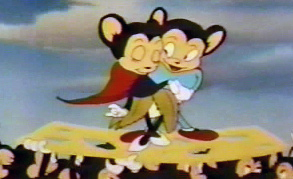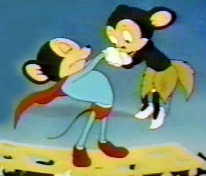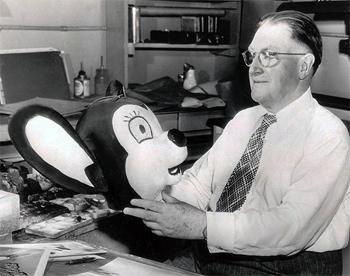The initial formula consisted of an extended setup of a crisis which needs extraordinary help to resolve and Mighty Mouse appears to save the day.
Mighty Mouse was originally voiced by Roy Halee, although Tom Morrison did Mighty's voice later on.
The early, operatic Mighty Mouse cartoons often portrayed Mighty Mouse as a ruthless fighter. He would dole out a
considerable amount of punishment, subduing the cats to the point of giving up their evil plan and running away.
Mighty Mouse would then chase down the escaping cats, and continue beating them mercilessly, usually hurling or punching
them miles away to finish the fight. A favorite move is to sudden fly up to just under a much larger opponent's chin and
thrown a blinding flurry of punches that leaves the defeated enemy reeling.
Mighty Mouse had two mouse girlfriends named Pearl Pureheart (in the cartoons) and Mitzi (in the comics during the 50s
and 60s), and his arch-enemy was an evil villain cat named Oil Can Harry (who originated as a human in the
earlier Terrytoons
as the enemy of Fanny Zilch). These characters were created for a series of Mighty Mouse cartoons that spoofed the old
cliffhanger serials of the days of silent film; the cartoons usually began with Mighty Mouse and Pearl Pureheart already
in a desperate situation, as if they were the next chapter of the serial. The characters often sang mock opera songs
during these cartoons. Mighty Mouse was also known for singing "Here I come to save the day!" when flying into action.
Mighty Mouse's hometown is Mouseville, populated mostly by little toon mice.
Mighty Mouse fought other villains, though most only appeared in one or two cartoons. In at least two cartoons, he faced a huge, dim-witted but super-strong cat named Julius Pinhead "Schlabotka" (this cat's name was only spoken and never spelled out). In another cartoon, titled The Green Line, the cats live on one side of the main street of a town and the mice on the other; a green line down the middle of the street serves as the dividing line. They agree to keep the peace as long as no one crosses it. An evil entity, a Satan cat, comes and starts the cats and mice fighting. Mighty Mouse appears and the evil spirit materializes tridents to attack him. This maneuver fails, and the devil cat disappears in a puff of smoke, like an air plane crashing to the ground. At the end, Mighty Mouse is cheered by mice and cats alike.
In the episode "Krakatoa", Mighty Mouse lassos the super-volcano Krakatoa, saving the island's inhabitants from the pyroclastic flow. Most memorably, a love-interest for Mighty Mouse makes her appearance, Krakatoa Katy.

Krakatoa Katy
The greatest hero of them all, Mighty Mouse, easily brushes aside molten lava and stems the tide of an island volcano,
set off by the torrid dancing of Krakatoa Katy, the hottest dancer of them all.
Then he carries all of the island natives to the safety of higher ground,
where Katy leads them all in a jive-chanting jitterbug dance in tribute to their hero.
Lyrics
Krakatoa Katy, She ain't no lady,
when she starts to shake her sarong,
Now Katys out in full array
For Mighty Mouse has saved the day,
for Kathy, Kathy, Krakatoa Katy.
Mighty Mouse was not extraordinarily popular in theatrical cartoons, but was still Terrytoons' most popular character. What made him a cultural icon was television. Paul Terry sold the Terrytoon company to CBS television in 1955. The network began running The Mighty Mouse Playhouse in late 1955; it remained on the air for nearly twelve years (and featured The Mighty Heroes during the final season). Mighty Mouse cartoons became a staple of children's TV programming for a period of over thirty years, from the 1950s through the 1980s.
Despite the character's popularity on TV, Terrytoons produced only a handful of "Mighty Mouse" cartoons in the 1959-61 time frame; the company evidently believed that the existing library of "Mighty Mouse" episodes were enough to keep youngsters tuning-in to CBS every Saturday morning.
At least some early vinyl credits the original theme song to The Terrytooners, Mitch Miller and Orchestra, but recent publishing has generally credited The Sandpipers
The Many Origins of Mighty Mouse It was fairly common for the writers of Mighty Mouse to change things about his back story often, since these were just short cartoons mainly composed of sight gags. Just what do we know about Mighty Mouse?
In his first cartoon, "The Mouse of Tomorrow" (1942), Mighty Mouse is an ordinary mouse who gets his super powers from eating foods at the super market. Later, in the cartoon "He Dood it Again" (1943), they still stick to this story, saying that Mighty Mouse (Super Mouse) lives in the super market.
But supermarkets do get boring, and in "Pandora's Box" (1943) he was given another origin. As the ordinary boyfriend mouse of Pandora "long, long, ago", he takes vitamins A, B, C, D, E, and XYZ to become Mighty Mouse (Super Mouse).
 
Most of the time, Mighty Mouse's origin is ignored. But one recurring element is where and what time period Mighty Mouse lives. Unless we're told otherwise, we're supposed to assume that Mighty Mouse is fighting evil in present-day America. But in some cartoons we're told the story takes place "long ago" in some undeterminable time period in some place of western civilization such as a big city, a little town or a quaint little forest. "The Pirates" (1945) is unique, because Mighty Mouse lives in the jungle like a Tarzan-styled adventurer. Later in "Bad Bill Bunion" (1945) Mighty Mouse is in the Old West. The funny thing about this is when Bad Bill Bunion reprises his role in "The Jailbreak" (1946), him and Mighty are in present-day. In fact, in the latter cartoon, Bad Bill is pursued by the U.S. Army, Navy, and Air Force, but it is Mighty Mouse who captures him! "Krakatoa" (1945) finds Mighty Mouse in a tropical locale.
Mighty Mouse was not extraordinarily popular, but he did become a cultural icon after Paul Terry sold the Terrytoon
cartoon library to broadcast television. Mighty Mouse cartoons became a staple of children's TV programming for a period
of over thirty years, from the 1950s through the 1980s.
|







